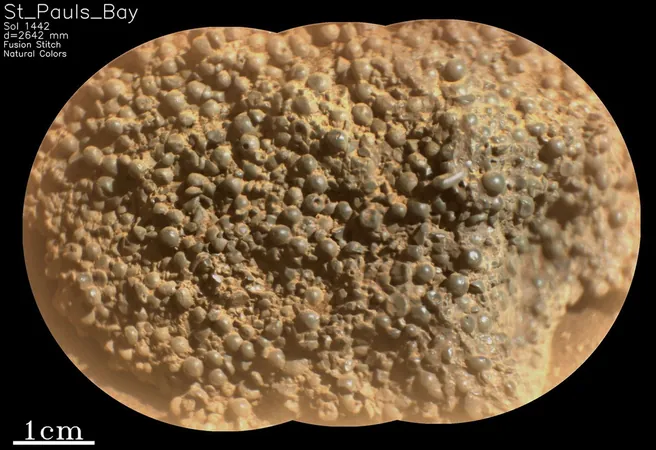
Mysterious Spherical Structures Discovered on Mars: What Could They Mean for the Planet's History?
2025-03-24
Author: Wei
Introduction
Last week, the Perseverance Science Team found themselves bewildered by a peculiar rock formation on Mars, which is made up of hundreds of millimeter-sized spheres. This discovery has sparked intense curiosity among scientists who are now delving into the origin of these enigmatic structures.
The Discovery at Broom Point
Perseverance, the Mars rover, has been exploring Broom Point on the lower slopes of Witch Hazel Hill, part of the Jezero crater rim, for the past two weeks. The area had previously shown distinctive light- and dark-toned bands when viewed from orbit. Recently, the rover successfully abraded and sampled one of the lighter-toned rock beds. It was during this encounter that Perseverance noticed an unusual texture in a nearby rock, designated "St. Pauls Bay" by the team.
Characteristics of the Spheres
Upon closer examination, the rock appeared to consist of numerous dark gray spheres, some exhibiting elongated, elliptical shapes while others showed broken angular edges, possibly indicating fragments of spherules. Remarkably, some of these spheres even displayed tiny pinholes. The question now looms: what geological phenomenon could create such extraordinary features?
Historical Context of Spherical Structures on Mars
This isn't the first instance of spherical shapes being discovered on Mars. In 2004, the Mars Exploration Rover Opportunity identified what became known as "Martian Blueberries" at Meridiani Planum. The Curiosity rover later observed similar spherules in the rocks at Yellowknife Bay in Gale Crater. Just months ago, Perseverance also found popcorn-like textures within sedimentary rocks exposed in the inlet channel of Jezero Crater, known as Neretva Vallis.
Possible Formation Mechanisms
In previous discoveries, these spherules were often interpreted as concretions, geological formations created by groundwater interacting with rock pore spaces. However, spherules can also form through different processes on Earth, such as the rapid cooling of molten rock droplets ejected during volcanic eruptions, or the condensation of vaporized rock following meteorite impacts.
Importance of Understanding Formation
Determining the method of formation for the spherules at St. Pauls Bay is crucial, as each possibility could significantly alter our understanding of their geological history. Notably, St. Pauls Bay is classified as "float rock" by geologists, indicating that it is not situated in its original place.
Future Research Directions
The research team is striving to connect the unique texture observed at St. Pauls Bay to the larger geological framework of Witch Hazel Hill. Initial findings suggest a potential correlation with one of the dark-toned layers identified from orbit. Establishing the geological context of these features is essential for understanding their origin and significance, not only for the Jezero crater but for Mars’ broader geological narrative.
Conclusion
Could these strange spherules provide crucial insights into Mars' watery past or indicate the planet's volcanic activity? The research continues, with scientists eager to unlock the mysteries hidden within the Martian landscape. Stay tuned as we follow this story and reveal what these astonishing findings could mean for the future of Mars exploration!




 Brasil (PT)
Brasil (PT)
 Canada (EN)
Canada (EN)
 Chile (ES)
Chile (ES)
 Česko (CS)
Česko (CS)
 대한민국 (KO)
대한민국 (KO)
 España (ES)
España (ES)
 France (FR)
France (FR)
 Hong Kong (EN)
Hong Kong (EN)
 Italia (IT)
Italia (IT)
 日本 (JA)
日本 (JA)
 Magyarország (HU)
Magyarország (HU)
 Norge (NO)
Norge (NO)
 Polska (PL)
Polska (PL)
 Schweiz (DE)
Schweiz (DE)
 Singapore (EN)
Singapore (EN)
 Sverige (SV)
Sverige (SV)
 Suomi (FI)
Suomi (FI)
 Türkiye (TR)
Türkiye (TR)
 الإمارات العربية المتحدة (AR)
الإمارات العربية المتحدة (AR)